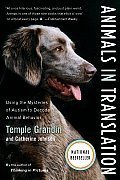
I'm currently reading a book called Animals in Translation: Using the Mysteries of Autism to Decode Animal Behavior by Temple Grandin, a woman who is, herself, a highly-functioning autistic person with a PhD in animal behavior. This book is fascinating, not only for her unique insights into animal behavior, but also for her unique insights into what it is like to have autism. As one reviewer notes, it's difficult to tell if this is a book that uses autism to help describe how animals think or if it's a book that uses animals to help describe how autistic people think. Either way, it is a fascinating read.
Grandin's premise is that people with autism think differently than "normal" people, and this different way of thinking is similar to the way animals perceive and think about their world. She explains how autistic people tend to think in pictures rather than words and often do not have the ability to draw complex, abstract conclusions based on what they are perceiving. Not being able to effectively process all the sights and sounds around them can result in a sort of sensory overload and difficulty functioning in the normal human world. She explains how autistic people tend not to see the "big picture" and are sometimes completely immersed in the details (e.g. autistic savants who can drop a box of matches and count them almost instantly).
Grandin cites research in animal behavior that suggests animals also think chiefly in pictures and, similar to some autistic people, can perform amazing feats of talent and focus, but do not necessarily extrapolate what they are perceiving into abstract thoughts and ideas in the same way normal humans do. That is not to say animals don't think or feel emotions, quite the contrary, says Grandin. By using this vastly different experience of human perception and thought, she offers a window into how animals may perceive the world and offers the perspective that there are many forms of thinking and intelligence beyond the normal human way.
The book is also interesting for the way Grandin uses language. She writes about human and animal emotions, yet her writing is itself almost devoid of emotion. She uses a lot of anecdotal evidence as well as scientific evidence to support her positions, but by far, the most interesting aspects of the book for me are her descriptions of her own experiences in the world of humans and animals. It's rare to get a glimpse of how the world looks to an autistic person, and I think she makes some compelling arguments for how understanding autism may help bridge the gap in understanding how animals and humans think in different ways.
As for understanding Baxter, well, it does explain some of his behaviors pretty well. I'll write more about that in future posts. Right now, I just look forward to finishing the book, and I'm adding it to The Truth About Dogs on my list of most interesting animal books.
- Scruffy Dogs Rule
1 comment:
Hey gal! Just wanted to check in with you to see how you are doing.
That book sounds *REALLY* interesting!! I love the picture of Baxter's "bed-head." LOL!! I bet he's a real hoot! :)
Hope you're doing well! Check in with us at Endo Buddies when you get a chance.
{{{HUGS}}}
Mimi
Post a Comment